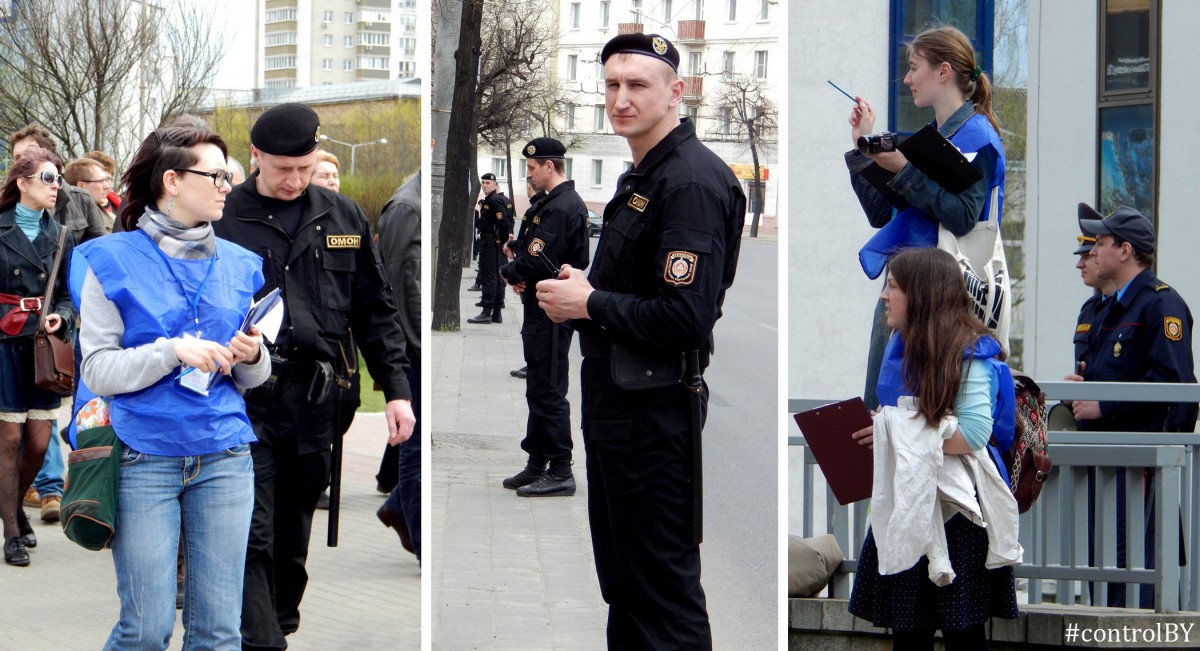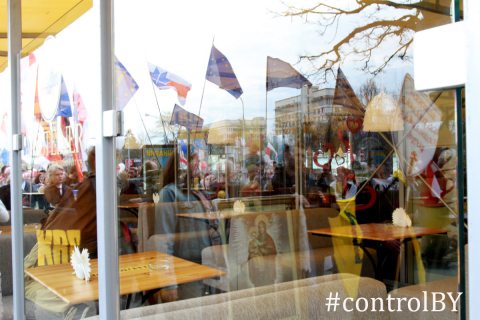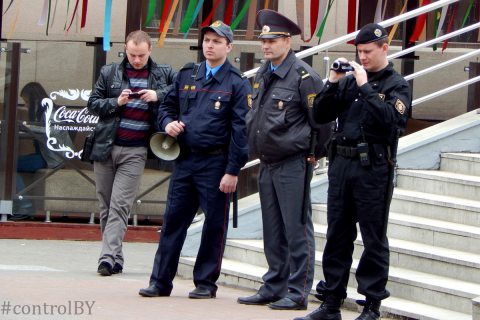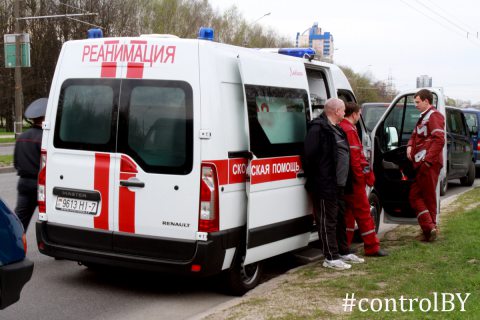Report on the results of monitoring Čarnobyĺski šliach 2015 demonstration (photo)
Findings
The practice of holding mass events in Minsk has not undergone significant changes: issues of concern still include lack of communication and obstacles in identifying police officers, as well as the inability to freely move along the route of the demonstration. Of greatest concern is the ongoing practice of arbitrary detentions and judicial harassment of some protesters (detention of Viktar Shaputska and Vital Kalinouski). The organizers still faced obstacles linked to a requirement of the Minsk City Executive Committee to cover expenses of maintaining public order, providing first aid and a clean-up of the territory during and after the mass event. At the same time, these measures are a positive duty of the State to ensure the right to peaceful assembly.
Another negative factor was instances of threats to observers from law enforcement agencies.
Monitoring methodology
For several years, the Belarusian Helsinki Committee and the Human Rights Center "Viasna" have been conducting systematic monitoring of public events in Minsk on the basis of an original methodology, which includes: the recruitment and training of observers in principles of public control and standards of peaceful assembly and monitoring methodology; filling in a questionnaire during observation; processing of questionnaires and writing the monitoring report. The questionnaires were jointly developed by the two human rights organizations and include questions about opportunities for the observers and the media, behavior of the organizers and participants of mass events, police officers, as well as the presence of an ambulance. Observers are allowed to observe only if they agree to comply with the rules and principles of observation (independence and political neutrality, description of the facts, rather than opinions, non-interference in the event, commitment to the principles of law: rejection of all forms of violence and discriminatory practices; correct behavior). During the execution of their duties, observers do not join the demonstration. They are marked by an observer’ badge and blue jackets.
Background information
Immediately prior to the date of the mass event, the observers had communication with the organizers, who provided a copy of the applications for the demonstration scheduled for 26 April 2015, and a reply from the Minsk City Executive Committee. According to the reply signed by the deputy chairman of the Minsk City Executive Committee I.V. Karpenka, five applicants (Yanukevich A.A., Hubarevich Y.I., Kuchuk D.L., Rymasheuski V.A., Dabratvor I.M.) were allowed to demonstrate from 2 to 4 p.m. along the following route: gathering of participants outside the cinema Kastryčnik; demonstration route — Niezaliežnasci Avenue – Surhanava Street – Arloŭskaja Street to the intersection with Karastajanavaj Street and the memorial sign “Victims of Chernobyl” with the total number of participants of 900 people. The only change in comparison with the application - reducing time of the initial gathering by half an hour. The Minsk City Executive Committee also ordered the organizers to sign contracts for the provision of services for the protection of public order, healthcare services and a clean-up of the territory. According to the organizers, the total amount of contracts with Minsk police amounted to 13.5 million rubles.
Minsk police was notified about the presence of observers during the demonstration with a request to ensure their safety and to communicate with them.
The mass event was continuously observed by 13 observers who had been properly trained and carried IDs.
The course of the mass action
- With the declared number of participants of 900 people, the number of demonstrators at the gathering point was about 540 people. About 450 people participated in the middle of the route. Outside the Chernobyl chapel, there were 480 people.
- It was difficult to determine the number of law enforcement employees because of the lack of markings on a large part of employees. In particular, there were about 10 traffic police officers, 10 people in the uniform labeled “Police”, about 30 persons with the inscription “Riot Police”, and about 50 in civilian clothes with distinctive features (headphones, walkie-talkies). The heads of Minsk police and the district police departments were in civilian clothes, unmarked. The police officers carried handcuffs, rubber sticks, flash distraction devices, special chemicals.
- There were no obstacles to the gathering.
- In general, there were no obstacles to the work of the media, but a journalist was not allowed to go up the stairs of the cinema at the gathering point.
- Obstruction to the observers took place in three cases: 1) observers with the function of counting the demonstrators were not allowed to go up the stairs of the cinema; 2) there was a threat to the observer who photographed police officers; they asked additional questions and warned of restrictions on such actions; 3) observers who were responsible for communication with the organizers and government officials were not able to get any information on safety measures from police officers, riot policemen, traffic policemen, who ignored appeals or answered “No comment”. Employees of the Executive Committee rudely refused to speak with the observers. Senior representatives of Minsk police not only did not answer the questions, but also threatened with prosecution “in the case of the obstacles to work”, asked about the place of training of observers.
- All organizers of the public event carried badges; there was no group of participants with a special function of control of the demonstration and its protection on behalf of the organizers.
- There were no calls for violent action on the part of the participants (the slogan “Glory to the Nation - Death for the Enemy” is not regarded as a call for violent action due to lack of specification of the “enemy” in this context).
- The participants used the following posters and banners: “Donations to Yauhen Vaskovich, balloons with the words “Long Live Belarus!”, a poster “Chernobyl - An Open Wound”, T-shirts “Stop Putin”, “Putler Kaput”, “No to Electoral Farce”, “Lukashenka, Resign!”, poster “Nuclear Russian is More Terrible Than Chernobyl”, an installation with a gallows and the words “And maybe it’s the way it should be?”, a banner “No to Nuclear Threat”, “Your Silence is Your Consent”, “For a Nuclear-Free World”, “Chernobyl Yesterday – Astraviec Tomorrow”, “Chernobyl is Our Pain”, a poster with a picture of death “Want NPP for My Grandson”, photos of Grybauskaitė and Lukashenko signed “Europe Love Rashizm”, a banner “Russia is War”, posters “Poor Kuzia”, “Union with Imperial Russia – Spiritual Chernobyl”, “No to Astraviec NPP”, Ukrainian state coat of arms on a flag of 1.5x1 meters. The demonstrators also collected signatures for nomination of Mikalai Statkevich as a single presidential candidate from the opposition.
- The demonstrators used the following symbols: white-red-white flags, flags of Ukraine, flags of the Young Front, Young Belarus, European Belarus, Belarusian Christian Democracy party, the Belarusian Popular Front, the sign of nuclear contamination.
- The following slogans were used: “Long Live Belarus!”, “Glory to Ukraine - Glory to the Heroes”, “Glory to the Nation - Death for the Enemy”, “Who’s not Jumping he’s a Moscal”, “There’s no Peaceful Atom”, “Police With the People!”, “Together and Forever”, “No to NPP in Belarus”.
- There were no requirements to the participants by the organizers, the participants followed all the requirements from law enforcement employees.
- During the mass event, the police did not use physical force, but one observer recorded the fact of the use of force during the detention of one of the participants after the completion of the demonstration (Viktar Shaputska, in Bangalore Square, 4 p.m., police car with license plate number 9423 K-7, armlocked and pushed into the van).
- Police officers followed several demonstrators after the end of the event, resulting in the detention of two people – Viktar Shaputska and Vital Kalinouski. Both were probably detained only for the use of Ukrainian flags during the demonstration, released without charges an hour later from the Saviecki district police department of Minsk.
- The column was broken at the traffic lights and by the traffic police and ordinary police, prohibiting the first part of the column to wait; as a result, the column was divided at the end of the route into 3 parts.
- The observers saw some 3-5 ambulances.
Recommendations
To the organizers:
1) to implement a more active communication with law enforcement agencies and participants, especially pay attention to ensure smooth movement through street intersections and arriving at the venue of the rally. If possible, arrange a leading group.
To the Minsk City Executive Committee:
2) not to unreasonably restrict the right to peaceful assembly, not to devalue the right by arbitrary changes in the time of the mass event and the imposition on the organizers of obligations to pay for the maintenance of public order, healthcare services and a clean-up of the territory;
To law enforcement officers:
3) to put an end to the ongoing practice of arbitrary detention after peaceful assemblies.
4) to maintain public order during mass events in uniform and be labeled with identification cards (badges or breast signs).
5) to delegate a contact person from among police officers to communicate with the observers, the media and the organizers of the event.
6) to ensure the smooth movement of the column of participants through street intersections with the cessation of movement of vehicles.
To entities possessing the right of legislative initiative:
7) to initiate changes in the legislation to bring it in line with international standards on freedom of peaceful assembly.
























